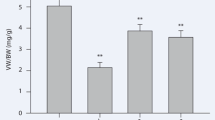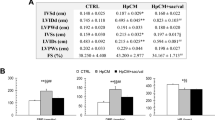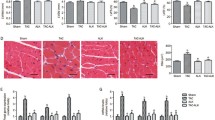Summary
The effects and mechanism of long-term angiotensin converting enzyme inhibitor (ACEI) Forsinopril on left ventricular hypertrophy of spontaneous hypertension rat (SHR) and left ventricular pressure overloading rat were studied. The left ventricular index (left ventricle weight/body weight) was used to evaluate left ventricular hypertrophy and the in situ hybridization to investigate the TGF-β1 gene expression in left ventricle. The results showed that Forsinopril significantly decreased the left ventricular index of both SHR and left ventricle pressure overloading rat. Forsinopril reduced the integral photic density of TGF-β1 gene statement from 2.836±0.314 to 1.91±0.217 (P<0.01,n=8) of SHR rat and from 3.071±0.456 to 2.376±0.379 (P<0.01,n=8) of left ventricular pressure overloading rat respectively. It was concluded that Forsinopril could prevent the occurrence of left ventricular hypertrophy and reduce the TGF-β1 gene expression in left ventricle of both SHR and left ventricular pressure overloading rat significantly.
Similar content being viewed by others
References
Liu Y, Leri A, Liu B Set al. Angiotensin II stimulation in vitro induces hypertrophy of normal and postinfarcted ventricular myocytes. Circ Res, 1998, 82: 1145
Michel L, Pascal G, Christian Get al. Ramipril-induced regression of left ventricular hypertrophy in treared hypertensive individuals. Hypertension, 1995, 25: 92
Kim N N, Villarreal F J, Printz M Pet al. Trophic effects of angiotensin II on neonatal rat cardiac myocytes are mediated by cardiac fibroblasts. Am J Physiol, 1995, 269 (3 Pt 1): E426
Kromer E P, Riegger G A. Effects of long-term angiotensin converting enzyme inhibition on myocardial hypertrophy in experimental aortic stenosis in the rat. Am J Cardiol, 1988, 62 (1): 161
Parker TG, Packer SE, Schneider MD. Peptide growth factors can provoke “fetal” contractile protein gene expression in rat cardiac myocytes. J Clin Invest, 1990, 85 (2): 507
Parker T G, Chow K L, Schwartz R Jet al. Differential regulation of skeletal alpha-actin transcription in cardiac muscle by two fibroblast growth factors. Proc Natl Acad Sci USA, 1990, 87 (18): 7066
Rossi P, Karsenty G, Roberts A Bet al. A nuclear factor 1 binding site mediates the transcriptional activation of a type I collagen promoter by transforming growth factor-beta. Cell, 1988, 52 (3): 405
Inagaki Y, Truter S, Ramirez F. Transforming growth factor-beta stimulates alpha 2 (I) collagen gene expression through a cis-acting element that contains an Sp1-binding site. J Biol Chem, 1994, 269 (20): 14828
Jimenez S A, Varga J, Olsen Aet al. Functional analysis of human alpha 1 (I) procollagen gene promoter. Differential activity in collagen-producing and-nonproducing cells and response to transforming growth factor beta 1. J Biol Chem, 1994, 269 (17): 12684
Edwards D R, Murphy G, Reynolds J Jet al. Transforming growth factor beta modulates the expression of collagenase and metalloproteinase inhibitor. EMBO J, 1987, 6 (7): 1899
Laiho M, Saksela O, Andreasen P Aet al. Enhanced production and extracellular deposition of the endothelial-type plasminogen activator inhibitor in cultured human lung fibroblasts by transforming growth factor-beta. J Cell Biol, 1986, 103 (6 Pt 1): 2403
Sharma H S, van Heugten H A, Goedbloed M Aet al. Angiotensin II induced expression of transcription factors precedes increase in transforming growth factor-beta 1 mRNA in neonatal cardiac fibroblasts. Biochem Biophys Res Commun, 1994, 205 (1): 105
Kim S, Ohta K, Hamaguchi Aet al. Angiotensin II type I receptor antagonist inhibits the gene expression of transforming growth factor-beta 1 and extracellular matrix in cardiac and vascular tissues of hypertensive rats. J Pharmacol Exp Ther, 1995, 273 (1): 509
Campbell S E, Katwa L C. Angiotensin II stimulated expression of transforming growth factor-betal in cardiac fibroblasts and myofibroblasts. J Mol Cell Cardiol, 1997; 29 (7): 1947
Tsutomu Y, Issei K, Sumiyo Ket al. Angiotensin II Partly Mediates Mechanical Stress Induced Cardiac Hypertrophy. Circ Res, 1995, 77: 258
Kazuhisa K, Hiroaki M, Satoshi Met al. Mechanical Stretch Induces Enhanced Expression of Angiotensin II Receptor Subtypes in Neonatal Rat Cardiac Myocytes. Circ Res, 1996, 79: 887
Kurtz T W, Simonet L, Kabra P Met al. Cosegregation of the renin allele of the spontaneously hypertensive rat with an increase in blood pressure. J Clin Invest, 1990, 85 (4): 1328
Zhang L, Summers K M, West M J. Angiotensin I converting enzyme gene cosegregates with blood pressure and heart weight in F2 progeny derived from spontaneously hypertensive and normotensive Wistar-Kyoto rats. Clin Exp Hypertens, 1996, 18 (6): 753
Hilbert P, Lindpaintner K, Beckmann J Set al. Chromosomal mapping of two genetic loci associated with blood-pressure regulation in hereditary hyperten-sive rats. Nature, 1991, 353 (6344): 521
Author information
Authors and Affiliations
Additional information
HUANG Kai, male, born in 1969, M. D., Ph. D, Lecturer
Rights and permissions
About this article
Cite this article
Kai, H., Guizhu, D. The effect and mechanism of forsinopril on ventricular hypertrophy of SHR and left ventricular pressure overloading rat. Current Medical Science 22, 17–20 (2002). https://doi.org/10.1007/BF02904778
Received:
Published:
Issue Date:
DOI: https://doi.org/10.1007/BF02904778




